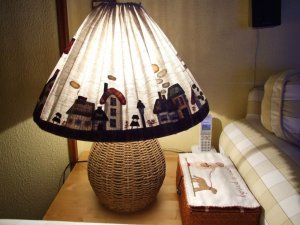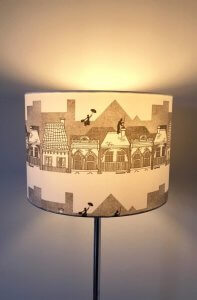How to Make Your Own Lampshades

There are so many different ways you can go about decorating your home. One option is to make items by hand. So today, we want to show you how to make your own lampshades.
When you add your own personal touch to your decorations and furniture, your home takes on a whole new dimension. The warmest and most welcoming homes are undoubtedly those in which you can get a feel for the inhabitants’ personalities. This sense of identity helps to create a pleasant and relaxing atmosphere.
Don’t worry if you’re not really sure how to go about making your own decorations. It’s simply a question of sitting down and working out how you want your designs to look. Everyone has an imagination, so it’s time to let those creative juices flow, and put your artistic skills to good use.
Make your own lampshades – planning, designing, and materials

At some point, you may find you’ve grown tired of the decoration in your home, and you want to give it a bit of a makeover. One simple way to do this is through your lamps – both ceiling and table lamps. By changing the lampshades, you can create a whole new aesthetic.
Before you get started, it’s important to plan what you’re going to do. To do this, you need to work out what materials you’re going to need: fire-proof paper, double-sided tape, a metalized conical structure (or fitter), patterned fabric, a pen, and scissors.
Sprucing up your interior decor is a great way to spice up your life.
A step-by-step guide to making your own lampshades
The first step is to have all the necessary materials on-hand so that you don’t have to keep getting up to find things. Let’s take a look at the next steps:
- Sketch out the chosen design for your lampshade on paper, making sure to maintain the right proportions, and adjusting the measurements accordingly. It’s also important to measure the metal structure you want to attach it to, to ensure it’s the right size.
- Next, glue the fire-proof paper to the fabric. Be careful not to create creases, as they could spoil the overall shape of your lampshade. To avoid this, it’s best to work slowly, working one section at a time.
- The next step is to cut the fabric. Then, attach the double-sided tape to the fitter and along the edge of your lampshade. All you have to do now is attach the lampshade to the frame.
- Make sure that everything’s firmly attached. Any excess pieces of fabric can be trimmed with a box cutter or sharp pair of scissors. If there’s any fabric left over, you can simply tuck it behind the metal frame.
- Finally, clean the surface to remove any dirt or marks that may have appeared.
Color advice

When it comes to choosing the pattern or color for your lampshade, you’ll need to think about the type of lighting you want to create. Ideally, the aim is to create a warm and relaxing environment. Needless to say, using dark fabric will produce completely different results to lighter or warmer shades.
For example, if you decide to use black, dark blue, or other somber colors, it may act as a barrier. The lack of transparency traps the light, preventing it from illuminating your room.
It’s important to choose the right color for your fabric. Light, fresh fabrics are perfect for creating a positive atmosphere.
Use colors to create a calming and relaxing atmosphere.
Different types of lampshade
There are several types of lampshade to choose from. While cylindrical and conical shaped lampshades are the most common, you can also find oval, spherical, hemispherical and geometric shapes.
In the world of interior decor, there really are no limits. All you need is a little imagination, and you can transform your home into an original space where you can experiment with a more innovative aesthetic.
There are so many different ways you can go about decorating your home. One option is to make items by hand. So today, we want to show you how to make your own lampshades.
When you add your own personal touch to your decorations and furniture, your home takes on a whole new dimension. The warmest and most welcoming homes are undoubtedly those in which you can get a feel for the inhabitants’ personalities. This sense of identity helps to create a pleasant and relaxing atmosphere.
Don’t worry if you’re not really sure how to go about making your own decorations. It’s simply a question of sitting down and working out how you want your designs to look. Everyone has an imagination, so it’s time to let those creative juices flow, and put your artistic skills to good use.
Make your own lampshades – planning, designing, and materials

At some point, you may find you’ve grown tired of the decoration in your home, and you want to give it a bit of a makeover. One simple way to do this is through your lamps – both ceiling and table lamps. By changing the lampshades, you can create a whole new aesthetic.
Before you get started, it’s important to plan what you’re going to do. To do this, you need to work out what materials you’re going to need: fire-proof paper, double-sided tape, a metalized conical structure (or fitter), patterned fabric, a pen, and scissors.
Sprucing up your interior decor is a great way to spice up your life.
A step-by-step guide to making your own lampshades
The first step is to have all the necessary materials on-hand so that you don’t have to keep getting up to find things. Let’s take a look at the next steps:
- Sketch out the chosen design for your lampshade on paper, making sure to maintain the right proportions, and adjusting the measurements accordingly. It’s also important to measure the metal structure you want to attach it to, to ensure it’s the right size.
- Next, glue the fire-proof paper to the fabric. Be careful not to create creases, as they could spoil the overall shape of your lampshade. To avoid this, it’s best to work slowly, working one section at a time.
- The next step is to cut the fabric. Then, attach the double-sided tape to the fitter and along the edge of your lampshade. All you have to do now is attach the lampshade to the frame.
- Make sure that everything’s firmly attached. Any excess pieces of fabric can be trimmed with a box cutter or sharp pair of scissors. If there’s any fabric left over, you can simply tuck it behind the metal frame.
- Finally, clean the surface to remove any dirt or marks that may have appeared.
Color advice

When it comes to choosing the pattern or color for your lampshade, you’ll need to think about the type of lighting you want to create. Ideally, the aim is to create a warm and relaxing environment. Needless to say, using dark fabric will produce completely different results to lighter or warmer shades.
For example, if you decide to use black, dark blue, or other somber colors, it may act as a barrier. The lack of transparency traps the light, preventing it from illuminating your room.
It’s important to choose the right color for your fabric. Light, fresh fabrics are perfect for creating a positive atmosphere.
Use colors to create a calming and relaxing atmosphere.
Different types of lampshade
There are several types of lampshade to choose from. While cylindrical and conical shaped lampshades are the most common, you can also find oval, spherical, hemispherical and geometric shapes.
In the world of interior decor, there really are no limits. All you need is a little imagination, and you can transform your home into an original space where you can experiment with a more innovative aesthetic.
All cited sources were thoroughly reviewed by our team to ensure their quality, reliability, currency, and validity. The bibliography of this article was considered reliable and of academic or scientific accuracy.
- Campbell, Deanna: Arreglos para el hogar, Albatros, 2006.







